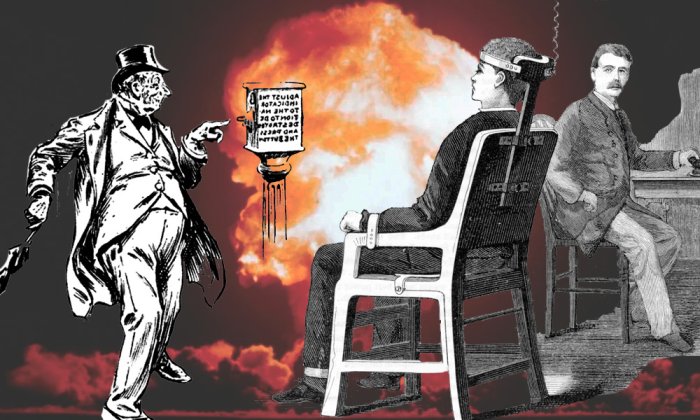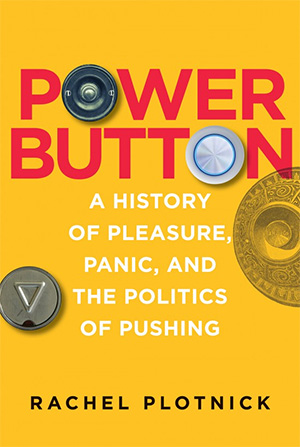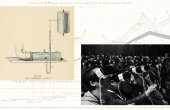Of War and Electric Death: A Brief History of Push-Button Anxiety

In an 1892 article titled “The End of War,” author J. F. Sullivan envisioned a world where “war seemed to grow ever more terrible; until it came to such a pass that a single human being could destroy a whole nation by simply pressing a small button with his finger.” As Sullivan imagined, it was not a crazed dictator or power-hungry politician who blew up the world, but rather a bumbling gentleman who unwittingly and effortlessly pushed a button that he happened to encounter without realizing what effects the button would trigger.

Even then, 50 years before the political anxieties generated by the push-button warfare of the Cold War era, pushing buttons came to symbolize a fear of long-distance, instantaneous warfare. Although push-button warfare existed only in popular imagination as portents of a future where button pushing could end the lives of everyone in a country, or even the world, in these prophecies, an all-powerful button pusher could enact swift, irreparable effects with a single press by setting unstoppable forces in motion. The reachability enabled by digital command also produced anxiety — if anyone could gain access to a push button, how could society maintain control over the unskilled, incompetent, or evil-doing controller?
If anyone could gain access to a push button, how could society maintain control over the unskilled, incompetent, or evil-doing controller?
To this end, because of buttons’ simplicity and the way they initiated cause and effect, fiction writers also viewed them as the mechanism that could trigger an apocalyptic ending for humanity if buttons fell into the wrong hands. One author imagined a scenario in which Thomas Edison stood at the apex of a conflict between Great Britain and the United States, possessing the electric power to eradicate whole countries from the map: “In order to avert future trouble,” the fictional Edison proclaimed, “I think it would be best to destroy England altogether.” After instructing his assistant to touch button number four, which obliterated the country, Edison concluded, “If we should ever be at war with any other nation, you have only to notify me. I have an electric button connecting with every foreign country which will destroy it when pressed. In ten minutes I could destroy every country in the world, the United States included.”
This bleak portrait of Edison as an all-too-powerful scientist at a switchboard of buttons controlling the world spoke to the antibutton contingent’s greatest fears. In such a scenario, with decision making localized in one person’s hands and the ability to change the course of human history with so little effort, this writer and others imagined the push button at the center of the race’s ruin. Buttons conjured fears of all-or-nothing actions that could spiral out of control. Although this kind of catastrophic war did not exist at that moment, depictions of it presciently foretold the paranoia that would accompany a world where geopolitics rested on a push or press at the hands of a digital commander. Moral watchdogs frequently spoke out about this kind of warfare, whether malicious or unintentional.
Pushing a button to blow up a mine, start world’s fair machinery, or initiate warfare each constituted an example of buttons as tools of activation. Thinking about pushing a button to set these forces into motion meant to confront an essential paradox, according to scientist Julius Robert Mayer:
Human nature is such that people like to achieve the greatest effects with the smallest possible means. The pleasure we take in firing a weapon is an eloquent example of this. … But even if activating things is an inexhaustible source of permissible joy and harmless pleasure, we must also note that this phenomenon can also lead to the most heinous crimes.
Where pushing a button certainly connoted effortless control, Mayer identified a theme common to the volatile nature of button pushing as a reversal of forces in the late 19th and early 20th centuries; the forceless force of a finger touch combined with a catastrophic or far-reaching effect could carry with it grave and sometimes irreparable — whether imagined or not — consequences. In part, this viewpoint reflected a discomfort with carrying out an action that triggered results which couldn’t be viewed by the button pusher.
Scholar and author George Herbert Palmer, in 1903, wrote to this effect: “When I touch a button, great ships are loaded on the opposite side of the earth and cross the intervening oceans to work the bidding of a person they have never seen.” Where users perceived buttons as erasing distance in some circumstances, they viewed them as perpetuators of distance in others.
Social debates routinely occurred about the morality of technological interventions from a distance: What ethical guidelines should one take into account when pressing a button thousands of miles away that could take the life of someone else? Should matters of life and death take place only in face-to-face contexts?
Onlookers feared that localizing control to an instant, decisive, and remote touch would provoke humanity’s darkest impulses.
Dr. A. R. Wallace, writing on examples of immorality and morality both hypothetical and real, concluded bleakly about the human condition that nothing “would restrain a poor, selfish, and naturally unsympathetic man from pressing the electric button which would at once destroy an unknown millionaire and make the agent of his destruction the honoured inheritor of his wealth.” Wallace believed that in times of desperation, anyone would hide behind the push button’s shelter of anonymity and take the life of another for his own gain. Here, push buttons acted as simplistic vehicles for getting away with murder. Onlookers feared that localizing control to an instant, decisive, and remote touch — made possible by the invisibility of the effects — would provoke humanity’s darkest impulses.
These fears, although grandiose in their description, were founded in material changes occurring in military technology. Of note, those observing increasingly mechanical warfare described a moral as well as a manual shift in the physical act of carrying out war. As the author Charles Morris wrote in 1898, “A modern battle-ship has grown to be an automatic machine, an instrument of warfare in which nothing is done by hand.” He remarked, “Now the hand has little to do, except to move levers, press electric buttons, open and close throttles, and the like.” Echoing sentiments common across industries, Morris contrasted manual labor from digital command — the minimalist intervention of hands pressing buttons seemed not to qualify as hand work, despite the fact that all of these controls would have necessitated routine gestures and adjustments to keep the battleship functioning appropriately.
This problem of the hand having “little to do” produced concern — and even outright indignation — in the late 19th century, when it came to matters of life and death. In particular, debates over the electric death penalty demonstrated a fundamental uneasiness with taking a life in a manner quite “‘insulated’ and at a remove from the body in question. In an 1888 essay on “Electric Killing,” Thos. D. Lockwood noted that, although electricity could allow people to communicate in myriad ways, “we have not yet pressed a key or a push-button for the deliberate purpose of killing anybody.” Lockwood wrote in response to a suggestion made in New York, outlined in a report from the Gerry Commission to begin using electricity for the death penalty, and he called this a “cold blooded proposition for the degradation of a noble science; and moreover one which is entirely uncalled for.”
Electricians convening at the National Electric Light Association Convention in the following year expressed similar concerns in a panel assessing the constitutionality of electrical capital punishment. Vocal dissenter Professor Anthony argued that no sheriff would want to “place the electrodes and touch the button which was to produce death.” He wagered that even after 100 years, electricians or other experts would still have to carry out the act because no nonexpert would take on such a weighty responsibility. Despite these outspoken rejoinders, only five months later, New York passed the Electric Execution Act, which conjectured that applying a scientific and technological method to executions would reduce public outrage toward capital punishment.
Given the “gentle pressure on the button” required to carry out executions, some also viewed the shift as a progression to “moral and intellectual rather than physical” ground, quite unlike hanging, stoning, beheading, or other more viscerally violent methods. Public interest in the death penalty crystallized around this modern, technologically superior and masterful form of control that could take a life. Push buttons combined with the electric chair to create a standardized, state-sanctioned form of justice that was described as “instantaneous” and “well calculated to inspire terror.”
Push buttons combined with the electric chair to create a standardized, state-sanctioned form of justice that was described as “instantaneous” and “well calculated to inspire terror.”
Removing labor from the operation via electric button provided a useful justification for managing deviant behavior while making the activity less overtly gruesome and brutal. Yet some worried that people did not know enough about electricity to use it effectively for execution, nor, as one author writes in the first issue of the now-defunct Belford’s Magazine, should the criminal “be put out of the way in the easiest possible manner for him.” Death penalty by button could be perceived as too simplistic and therefore unfit for its weighty task, given that it operated with the same touch as an electric bell push; from this perspective, a “reversal of forces” violated a tenet that human life should not be taken without effort.
The binary nature of electric death — life and death tethered to a switch — also produced mixed reactions. Describing how prisons would carry out electrical executions, Thomas Edison — who originally opposed the death penalty before taking a financial interest in the process — relied on the push button as the key mechanism in carrying out the deed. Edison famously remarked of this process, “When the time comes, touch a button, close the circuit, and,” he said with a snap of his fingers, “it is over.”
In reality, however, early forays into electrical executions often did not conform to the on/off binary that Edison and others promised. The first execution by electric chair — of prisoner William Kemmler — produced disastrous results when 17 seconds of applied electric current did not take the man’s life as expected. According to a New York Times article reporting on a subsequent death penalty case that would use the same method, the electricians responsible for the failure “have not forgotten that life apparently came back to Kemmler after it was thought that he was dead and the current was turned off.”
Far from the “snap” that could toggle between life and death, the realities of electrical capital punishment suggested that execution by button required an array of technical forces to come together successfully. In the ensuing years, push-button executions evolved into routine practice, viewed by many as a more humane way of killing than those of the past. By transforming violent physical actions into mere touch, push buttons stripped physical force from the death penalty act while leaving the forceful impact of death in its wake.
Although buttons sometimes functioned differently from how they were imagined in electrical execution, many continued to invest in the notion that buttons could provide instantaneous and direct retribution for those wronged, balancing out the scales of good and evil. In 1892, the Washington Post indeed reported that a father, after the death of his daughter, hoped that “I may be allowed to touch the button of the electric machine that kills the man that murdered my daughter.” Putting control in the hands of the victim, the push button could serve as a tool of empowerment, but it also raised societal concerns about what it meant to take a life with a single push. Those who advocated against button pushing believed human life was too sacred to take so easily. Pushing buttons prompted deep and sometimes unanswerable questions about society’s impulse to carry out life-and-death decisions from a distance, to put control within one person’s hands and under one person’s finger.
Given the wide array of interpretations about generating push-button effects at a distance, it became difficult to pin down whether buttons were purveyors of pleasure, panic, or some strange mixture of both emotions. Just as a society in the midst of industrialization and electrification had to negotiate what it meant to communicate at longer distances through technologies such as telegraphs and telephones, so too did the question of action at a distance prompt negotiation over what forces button pushers might set into motion.
Rachel Plotnick is an assistant professor of cinema and media studies at Indiana University Bloomington. This article is excerpted from her book “Power Button: A History of Pleasure, Panic, and the Politics of Pushing.”




